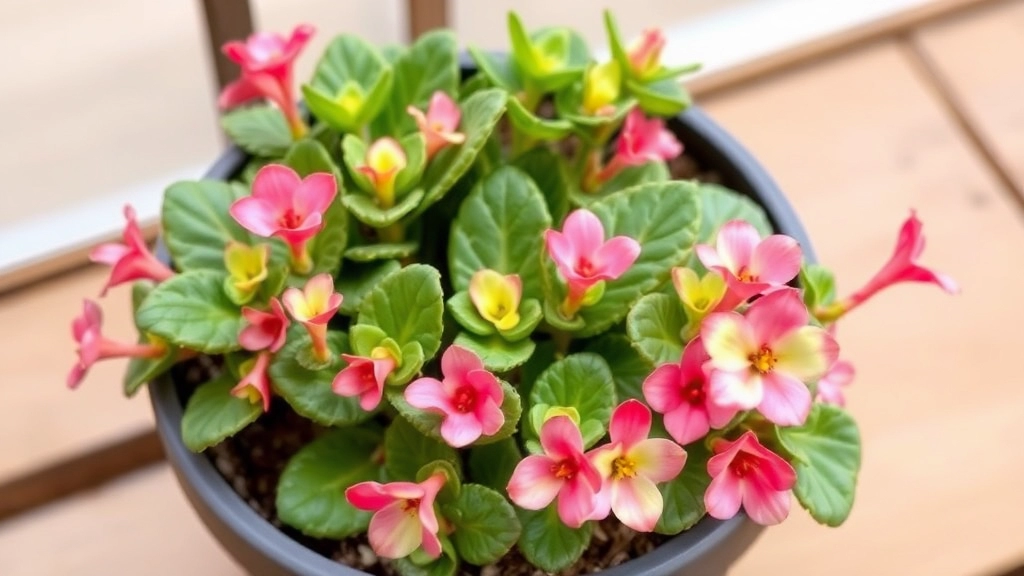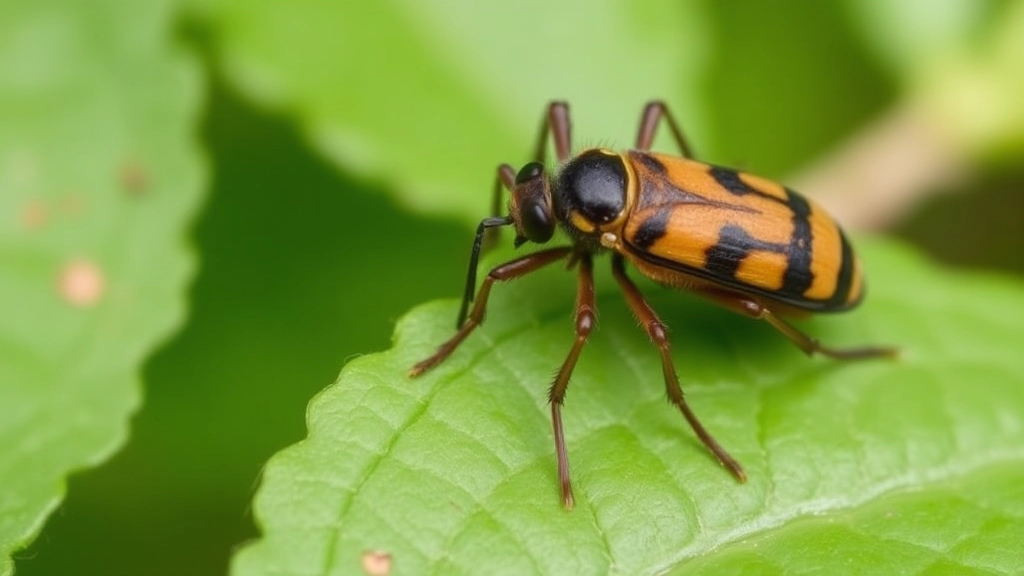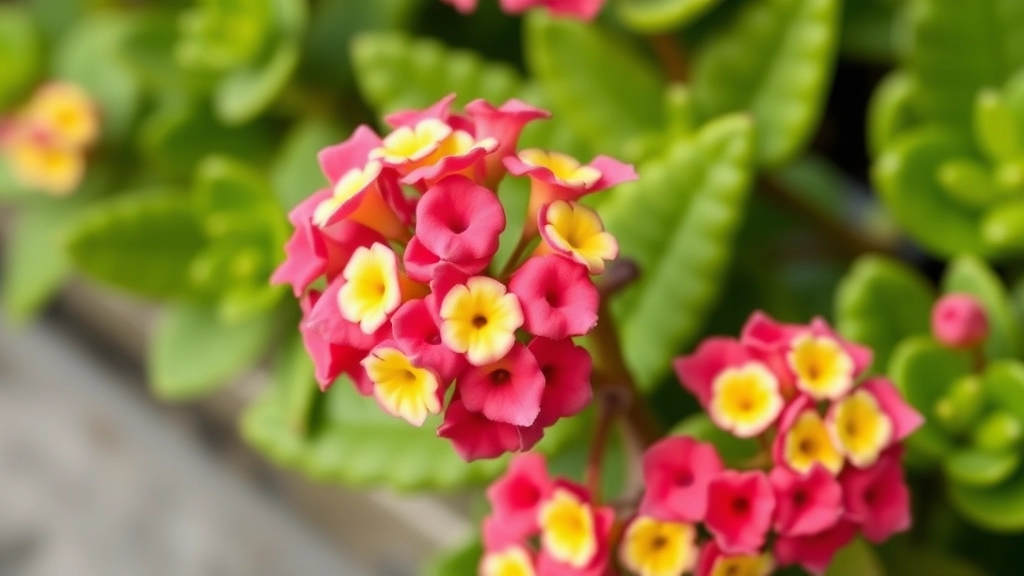Enhancing Your Gardening Skills with Flowering Kalanchoe
If you’re looking to enhance your gardening skills with the vibrant and resilient Flowering Kalanchoe, also known as Kalanchoe Blossfeldiana, you’ve come to the right place. This popular succulent is not only easy to care for but also adds a splash of colour to any space. Let’s dive into the essentials of optimal lighting and watering to ensure your Kalanchoe thrives.
Propagation of Kalanchoe Blossfeldiana
Propagation is another exciting aspect of growing Kalanchoe Blossfeldiana. With a few simple steps, you can multiply your collection and share this beautiful plant with friends. Additionally, we’ll explore methods to encourage reblooming, so your Kalanchoe continues to brighten your home season after season.
Additional Tips
Stay tuned for tips on pest control and creative decorating ideas to make the most of this versatile plant.
Optimal Lighting and Watering for Kalanchoe Blossfeldiana
When it comes to nurturing Kalanchoe Blossfeldiana, one of the most pressing concerns is ensuring optimal lighting and watering conditions. Many plant enthusiasts often wonder how to strike the right balance for these vibrant succulents.
Lighting Requirements
Kalanchoe Blossfeldiana thrives in bright, indirect sunlight. Here are some essential tips:
- Location: Place your plant near a window that receives ample light, but avoid direct sunlight, which can scorch the leaves.
- Duration: Aim for about 6 hours of light each day. If natural light is limited, consider using a grow light to supplement.
- Signs of Stress: If your plant’s leaves begin to stretch or lose their vibrant colour, it may indicate insufficient light. For more detailed information, check out our Kalanchoe Blossfeldiana leaf care tips and troubleshooting guide.
Watering Guidelines
Watering Kalanchoe can be tricky; too much or too little can lead to issues. Here’s how to get it right:
- Frequency: Water when the top inch of soil feels dry. This usually translates to watering every 2-3 weeks, depending on your climate.
- Method: Ensure thorough watering until it drains from the bottom. This promotes healthy root growth. For more tips, you might find our ultimate guide on caring for Kalanchoe succulents helpful.
- Seasonal Adjustments: Reduce watering in winter when the plant is dormant.
Effective Methods for Propagating Kalanchoe Blossfeldiana

So, you’ve got your Kalanchoe Blossfeldiana blooming beautifully, and now you’re wondering how to multiply that joy.
Propagation is a fantastic way to share the love (and plants) with friends or to fill your own space with more of these stunning flowers.
Here’s how to do it:
- Leaf Cuttings
– Choose a healthy leaf from the parent plant.
– Cut it cleanly at the base.
– Allow the cut end to dry for a day or two.
– Place it in well-draining soil and water lightly.
– Keep it in bright, indirect light. - Stem Cuttings
– Snip a healthy stem about 4-6 inches long.
– Remove the lower leaves to expose the nodes.
– Let it dry for a day.
– Plant it in soil, ensuring the nodes are buried.
– Water sparingly until roots develop. - Offsets
– Look for small offsets or “pups” at the base of the plant.
– Gently twist them off.
– Replant them in their own pots with fresh soil. - Seed Propagation
– Though a bit more challenging, you can collect seeds from mature flowers.
– Sow them in a seed tray with a light soil mix.
– Keep them moist and in bright light until they germinate.
Tips for Success:
- Always use clean tools to avoid disease.
- Be patient; some methods take longer than others.
- Keep the new plants in a warm, humid environment to encourage growth.
How to Encourage Kalanchoe Reblooming
Are you frustrated that your Kalanchoe Blossfeldiana isn’t blooming again? You’re not alone. Many plant enthusiasts find it challenging to get their Kalanchoe to flower more than once. Fortunately, there are effective strategies to encourage reblooming.
1. Light Conditions
Kalanchoe thrives in bright, indirect sunlight. Ensure your plant receives at least six hours of light daily. If natural light is limited, consider using grow lights to supplement.
2. Pruning
After the blooming period, prune back the spent flowers and any leggy growth. This not only improves the plant’s appearance but also encourages new growth.
3. Watering Schedule
Maintain a consistent watering routine. Allow the soil to dry out between waterings. Overwatering can lead to root rot, while underwatering can stress the plant, hindering its ability to bloom.
4. Fertilization
Feed your Kalanchoe with a balanced liquid fertilizer every two weeks during the growing season. A high-phosphorus fertilizer can promote blooming.
5. Dormancy Period
Kalanchoe requires a dormancy period to recharge. Reduce watering and stop fertilizing for about six weeks after blooming. This rest period is crucial for future blooms.
6. Temperature Control
Keep your Kalanchoe in a warm environment, ideally between 18°C to 24°C. Sudden temperature changes can stress the plant and affect blooming.
Common Pests and Diseases to Watch Out For

As we delve deeper into caring for Kalanchoe Blossfeldiana, it’s crucial to be vigilant about potential pests and diseases that could hinder its growth and beauty.
Common Pests
- Mealybugs
– Small, white, cotton-like insects.
– They suck sap from the plant, leading to stunted growth.
– Solution: Wipe them off with a cotton swab dipped in rubbing alcohol. - Aphids
– Tiny, green or black insects that cluster on new growth.
– They can cause curling leaves and yellowing.
– Solution: Spray with a mixture of water and dish soap to dislodge them. - Spider Mites
– Microscopic pests that create fine webs on the plant.
– They thrive in dry conditions and can cause leaf discoloration.
– Solution: Increase humidity and spray the plant with water to remove them.
Common Diseases
- Root Rot
– Caused by overwatering and poor drainage.
– Symptoms include yellowing leaves and a mushy stem.
– Solution: Ensure proper drainage and allow the soil to dry out before watering again. - Powdery Mildew
– A white, powdery fungus that appears on leaves.
– It thrives in humid conditions.
– Solution: Improve air circulation and apply a fungicide if necessary. - Leaf Spot
– Dark, water-soaked spots on leaves, often caused by fungal infections.
– Can lead to leaf drop if untreated.
– Solution: Remove affected leaves and avoid overhead watering.
Creative Uses in Home Decor and Landscaping
Are you looking for ways to enhance your living space with vibrant plants? Kalanchoe Blossfeldiana, with its striking flowers and lush foliage, offers a multitude of creative uses in home decor and landscaping.
Indoor Decor Ideas:
- Table Centerpieces:
Kalanchoe makes an eye-catching centerpiece for dining or coffee tables.
Place a pot on a decorative tray to elevate its appearance. - Window Sills:
These plants thrive in bright light, making them perfect for window sills.
Their colourful blooms can brighten up any room. - Hanging Baskets:
Consider using hanging baskets to showcase Kalanchoe.
This adds a touch of elegance and maximises vertical space.
Outdoor Landscaping Applications:
- Garden Borders:
Kalanchoe can be used as a border plant in flower beds.
Its vibrant colours create a beautiful contrast with other plants. - Rock Gardens:
Their hardy nature makes them suitable for rock gardens.
Pair them with stones for a natural, rustic look. - Patio Displays:
Arrange Kalanchoe in decorative pots on your patio.
This creates a welcoming atmosphere for outdoor gatherings.
FAQs About Flowering Kalanchoe (Kalanchoe Blossfeldiana)
What are the common methods for propagating Kalanchoe Blossfeldiana?
There are several effective methods to propagate Kalanchoe Blossfeldiana, including leaf cuttings, stem cuttings, offsets, and seed propagation.
How do I propagate Kalanchoe using leaf cuttings?
Choose a healthy leaf, cut it at the base, let it dry for a day or two, place it in well-draining soil, and water lightly. Keep it in bright, indirect light.
What is the process for stem cuttings?
Snip a healthy stem about 4-6 inches long, remove the lower leaves, let it dry for a day, plant it in soil ensuring the nodes are buried, and water sparingly until roots develop.
Can I propagate Kalanchoe from offsets?
Yes, look for small offsets or “pups” at the base of the plant, gently twist them off, and replant them in their own pots with fresh soil.
Is seed propagation possible for Kalanchoe Blossfeldiana?
Though more challenging, you can collect seeds from mature flowers, sow them in a seed tray with a light soil mix, and keep them moist and in bright light until they germinate.
What are some tips for successful propagation?
Always use clean tools, be patient, and keep the new plants in a warm, humid environment to encourage growth.
What are the common pests that affect Kalanchoe Blossfeldiana?
Common pests include mealybugs, aphids, and spider mites. Each can be managed with specific treatments such as rubbing alcohol, a water and dish soap mixture, or increased humidity.
How do I deal with mealybugs on my Kalanchoe?
Wipe them off with a cotton swab dipped in rubbing alcohol.
What should I do if my Kalanchoe has aphids?
Spray the plant with a mixture of water and dish soap to dislodge the aphids.
How can I get rid of spider mites on my plant?
Increase humidity and spray the plant with water to remove the spider mites.
What are common diseases that affect Kalanchoe Blossfeldiana?
Common diseases include root rot, powdery mildew, and leaf spot. Each requires specific care such as ensuring proper drainage, improving air circulation, and avoiding overhead watering.
How can I prevent root rot in my Kalanchoe?
Ensure proper drainage and allow the soil to dry out before watering again.
What should I do if my plant has powdery mildew?
Improve air circulation and apply a fungicide if necessary.
How do I treat leaf spot on my Kalanchoe?
Remove affected leaves and avoid overhead watering to prevent leaf spot.
References
-
How to Propagate Kalanchoe Plants
-
Kalanchoe Propagation: Four Easy Methods
-
How to Propagate Kalanchoe
